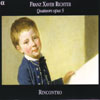Richter String Quartets Op 5, Nos 1, 2, 3.
Rich and influential quartets from a minor Moravian master
View record and artist detailsRecord and Artist Details
Composer or Director: Franz Xaver Richter, Wolfgang Amadeus Mozart
Genre:
Chamber
Label: Alpha
Magazine Review Date: 10/2006
Media Format: CD or Download
Media Runtime: 72
Mastering:
Stereo
DDD
Catalogue Number: ALPHA089

Tracks:
| Composition | Artist Credit |
|---|---|
| String Quartet No. 1 |
Franz Xaver Richter, Composer
Franz Xaver Richter, Composer Rincontro |
| String Quartet No. 2 |
Franz Xaver Richter, Composer
Franz Xaver Richter, Composer Rincontro |
| String Quartet No. 3 |
Franz Xaver Richter, Composer
Franz Xaver Richter, Composer Rincontro |
| Canon |
Wolfgang Amadeus Mozart, Composer
Rincontro Wolfgang Amadeus Mozart, Composer |
| (5) Fugues |
Wolfgang Amadeus Mozart, Composer
Rincontro Wolfgang Amadeus Mozart, Composer |
Author: DuncanDruce
Franz Xaver Richter (1709-89), born in Moravia, was educated in Vienna and became an important member, as singer and composer, of the musical establishment at the Mannheim court. He stands somewhat apart from the typical Mannheim style, however; his symphonies are more solid and conservative than the orchestral showpieces of Stamitz and Filtz. His string quartets (one set of six, published in 1768 but maybe written some years earlier) are remarkable for their contrapuntal dexterity and the richness and variety of their instrumental writing. One is tempted to believe that Haydn came across them before writing his Op 20 Quartets and was inspired by Richter’s example to develop the cello’s role as a solo instrument in the tenor register, with the viola providing a bass line. The second of Richter’s quartets has a fugal finale – not as with the examples in Haydn’s Op 20 a fully fledged fugue but combining fugal episodes with a sonata structure, as Mozart was to do in his K387.
Rincontro, playing on period instruments, interpret the music most convincingly, understanding and promoting its rhetorical style, and, with expressive phrasing and subtle rubato, breaking down anything in the music’s idiom that might seem rather stiff and formal. Only in one movement, the third quartet’s concluding Minuet, an elegant, simple piece, does this freely expressive style seem overdone. The Mozart Canon and the two Bach transcriptions (of Fugues 8 and 9 from Book Two of the “48”) provide a fascinating historical context for the Richter. A disc of more than usual interest, then, and I hope Rincontro will soon give us the rest of Richter’s Op 5.
Rincontro, playing on period instruments, interpret the music most convincingly, understanding and promoting its rhetorical style, and, with expressive phrasing and subtle rubato, breaking down anything in the music’s idiom that might seem rather stiff and formal. Only in one movement, the third quartet’s concluding Minuet, an elegant, simple piece, does this freely expressive style seem overdone. The Mozart Canon and the two Bach transcriptions (of Fugues 8 and 9 from Book Two of the “48”) provide a fascinating historical context for the Richter. A disc of more than usual interest, then, and I hope Rincontro will soon give us the rest of Richter’s Op 5.
Discover the world's largest classical music catalogue with Presto Music.

Gramophone Digital Club
- Digital Edition
- Digital Archive
- Reviews Database
- Full website access
From £8.75 / month
Subscribe
Gramophone Full Club
- Print Edition
- Digital Edition
- Digital Archive
- Reviews Database
- Full website access
From £11.00 / month
Subscribe
If you are a library, university or other organisation that would be interested in an institutional subscription to Gramophone please click here for further information.




